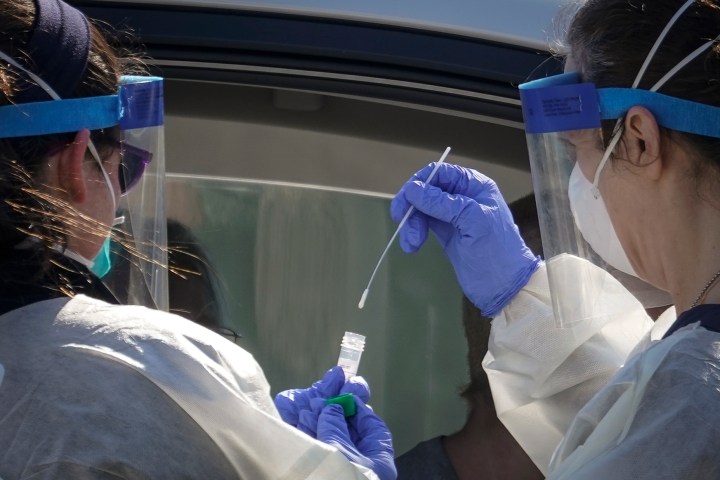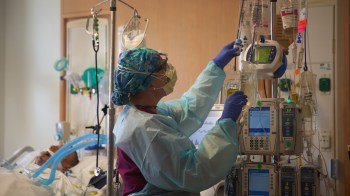
How much does a COVID-19 test cost?
Share Now on:
How much does a COVID-19 test cost?

Luke Abrahamson, a Minnesota resident, ended up paying about $500 for COVID-19 testing for his 3-year-old daughter over the past year.
While he and the rest of his family could get a free PCR test through Minnesota and Vault Medical Services, his youngest didn’t qualify.
“We had to go and find other testing solutions,” Abrahamson said. They eventually found a MedExpress, which he thought his insurance would cover. Although Congress passed laws that mandated free COVID-19 testing, prohibiting co-pays and deductibles, in many situations, people like Abrahamson are getting billed for the visit, not the test itself.
“That’s the frustrating part is, no, I don’t want to go in and get an appointment and get charged $110 for that when I just know I need the test,” Abrahamson said. “But there’s nothing that’s easily accessible to go get a test for a 3-year-old.”
While the national conversation on solutions to the COVID-19 crisis has shifted to mass vaccination, testing is still key to combating the spread of the virus.
“The proactive strategy of being out there and encouraging people to get tested isn’t anywhere near where it was a year ago. The emphasis is really on being out there and encouraging people to get vaccinated,” said Jorge Caballero, a San Francisco doctor who co-founded Coders Against COVID, a volunteer group that’s created a database of COVID-19 testing sites.
A federal mandate is requiring companies with more than 100 employees to mandate weekly COVID-19 tests for employees if they’re not vaccinated.
People also may need to get tested if they’re traveling, with some cruise lines calling for guests to show proof of a recent negative test — even if they’re fully vaccinated. Certain settings, like day camps and child care programs, may also call for proof of a negative COVID-19 test to attend or return if a child has been ill.
And while vaccines are shown to be highly effective in preventing severe disease, there are still breakthrough infections occurring, which would warrant testing, while children under 12 still cannot get vaccinated.
Some people have reported facing exorbitant bills, in the thousands, when they visit the doctor for testing. Even less expensive testing — either in a hospital setting or using over-the-counter, take-home COVID-19 tests — can add up for routine testing.
The price of a COVID-19 test at a hospital
Cynthia Cox, vice president at the Kaiser Family Foundation, said there are some exceptions to Congress’ mandate for free testing.
“If the test is not considered medically necessary, then the insurer or the health plan has a lot of leeway to decide whether or not to waive out-of-pocket costs,” Cox said. “So an example of that might be, for example, if your employer is requiring you to get tested on a frequent basis.”
The cost of a COVID-19 test is inconsistent, with prices at major hospitals ranging between $20 and $1,419 per test, with the median at $148, according to April 2021 data from a Kaiser Family Foundation analysis.
There are also several other reasons patients might receive bills, according to the KFF. Hospitals may bill for specimen collection and the visit itself, like in Abrahamson’s case, and federal rules don’t apply to certain private plans, such as short-term health insurance policies.
And for those who get an out-of-network COVID-19 test, although private plans are supposed to pay for the full price listed on a provider’s website, federal law does not stipulate rules if the cash price isn’t mentioned in the first place.
The price of rapid tests
Over-the-counter rapid tests, while they may end up costing less than the surprise bills some patients have received, are also overpriced, according to experts.
A set of two COVID-19 tests from Abbott or QuickVue cost around $24 at pharmacies such as CVS and Walgreens. They’re too expensive, given how much they cost to produce and how much is being subsidized by taxpayers through the Defense Production Act, said Caballero.
In September, President Joe Biden announced that Walmart, Amazon and Kroger would sell rapid, at-home tests for up to 35% less for three months, and that Medicaid would cover them for free. Some say that amount is still too high.
“There’s no reason, absolutely no reason, two of these tests should cost any more than $1 to $3,” Caballero said.
Globally, the costs tend to be far less — or free of charge. Tests cost $3.50 in India and under $1 in Germany, while your first 14 tests in the U.K. are free. Canada also gives out free tests to businesses.
“Many would advocate that that’s really the key toward this pandemic — is just constant, constant testing,” said Jennifer Kolker, a professor at Drexel University’s School of Public Health. “Those [rapid, at-home] tests are meeting a certain market, but they’re not the answer to sort of a bigger testing approach.”
Last week, the U.S. Food and Drug Administration authorized the over-the-counter home test Flowflex from ACON Laboratories’, which officials said should double at-home testing capacity. However, the company did not disclose the price of the test.
Some testing sites that provide rapid tests are also charging hundreds of dollars. The New York Times recently reported that the Omaha-based start-up GS Labs, which has done half a million tests since the start of the pandemic and has “a growing presence,” regularly bills $380 for COVID-19 tests. Health insurers have called its prices a form of price gouging, and many are refusing to pay its fees.
The scaling back of free testing sites
There was a marked transition from mass testing sites to mass vaccination sites earlier this year.
“A lot of the free testing sites that were funded through federal funds and operated through a public-private partnership at the federal level were phased out shortly after the Biden administration took over,” Caballero said.
Testing is still generally available through federally qualified health centers, public health clinics and primary care offices, he added.
There are different reasons for the reduction in mass testing sites: In a particular community, there may not be a great demand for testing. In others, there may be a great demand for both testing and vaccination, but there isn’t enough staff to manage both.
In Louisiana, Engy Ziedan — an assistant professor of economics at Tulane University — said “it was a disaster” after Hurricane Ida.
“We couldn’t find any mass testing places that were open for three, four weeks after Ida. And everybody had to get tested in health care centers. They weren’t sure if they would get a bill,” Ziedan said.
However, as demand has risen, some areas have decided to reopen testing centers, including counties in Pennsylvania, Colorado and Connecticut.
Christina Marsh Dalton, an associate professor of economics at Wake Forest University, said she recently took her son to their pediatrician to get tested, and had to submit a co-pay.
“The test is probably going to be free. But we were using the doctors’ time, and nurses were checking on us. That is not covered under the ‘must-be-free component,’” Dalton said.
She noted that even though she did want to get her child tested there, going to a free-testing clinic might have been more straightforward.
Luke Abrahamson said his family has stocked up on at-home PCR tests, just in case. The last time his daughter was tested was back in June. His two daughters are now in kindergarten and preschool and he’s unsure how he’ll navigate the year ahead.
“I’m concerned of — inevitably — when we will have to get a test done,” he said.
There’s a lot happening in the world. Through it all, Marketplace is here for you.
You rely on Marketplace to break down the world’s events and tell you how it affects you in a fact-based, approachable way. We rely on your financial support to keep making that possible.
Your donation today powers the independent journalism that you rely on. For just $5/month, you can help sustain Marketplace so we can keep reporting on the things that matter to you.


















